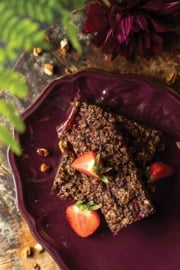Broccoli Rabe Lentil Ragu over Polenta

Broccoli rabe, also called rapini or Chinese broccoli in Asian markets, hits peak season in early spring. Its pronounced bitter taste is tamed somewhat with cooking. This elegant plant-based recipe proves that overcooked vegetables are sometimes a good thing.
Name game
Despite the name, leafy broccoli rabe tastes nothing like broccoli. Its uses and flavours are closer to turnip and mustard greens. All parts of broccoli rabe—stems, florets, and leaves—are edible. Just like broccoli rabe, broccolini is also a cruciferous vegetable but is a hybrid cross between broccoli and Chinese broccoli (also called gai lan or Chinese kale). It has long stalks with small broccoli-like florets and less of a bitter edge than rabe.
Broccoli Rabe Lentil Ragu over Polenta
Ingredients
- 1 Tbsp (15 mL) extra-virgin olive oil
- 2 shallots, chopped
- 3 garlic cloves, peeled and thinly sliced
- 1/2 tsp (2 mL) dried red pepper flakes
- 3/4 tsp (4 mL) salt, divided
- 1/4 tsp (1 mL) black pepper
- 1 lb (450 g) broccoli rabe, tough thick ends trimmed
- 1 1/2 cups (350 mL) canned no salt-added crushed tomatoes
- 2 Tbsp (30 mL) balsamic vinegar
- 2 cups (500 mL) cooked black (beluga) lentils or French green lentils
- 1 tsp (5 mL) dried thyme
- 1 cup (250 mL) medium-grain cornmeal
- 1/3 cup (80 mL) grated Parmesan cheese (optional)
Nutrition
Per serving:
- calories305
- protein15g
- fat5g
- saturated fat1g
- trans fat0g
- carbohydrates53g
- sugars5g
- fibre13g
- sodium488mg
Directions
01
In large skillet, heat oil over medium heat. Add shallots and garlic, and heat until garlic turns golden and shallots soften, about 2 minutes. Stir in red pepper flakes, 1/4 tsp (1 mL) salt, and pepper; heat for 30 seconds. Place broccoli rabe in pan and sauteu0301 for 3 minutes, stirring frequently. Pour in 3/4 cup (180 mL) water and bring to a simmer; heat over medium until rabe turns vibrant green and stems begin to soften, about 8 minutes, stirring occasionally. Add tomatoes to pan, bring to a simmer, and heat for 10 minutes. Stir in balsamic vinegar and lentils and heat through. Cover pan to keep warm while you prepare polenta.
02
In medium-sized saucepan, bring 4 cups (1 L) water to a boil. Add remaining 1/2 tsp (2 mL) salt and thyme to water and then slowly pour in cornmeal. Reduce heat to medium-low and cook, whisking frequently with wooden spoon to break up any clumps and to make sure cornmeal is not sticking to bottom of pan, until polenta is tender and creamy, about 15 minutes. If polenta becomes too thick too soon, loosen mixture by adding more water and continue cooking.
03
Divide polenta among shallow serving bowls and top with rabe ragu and Parmesan, if using.





